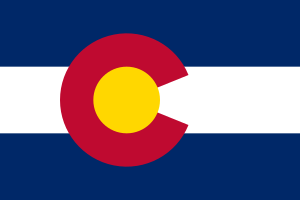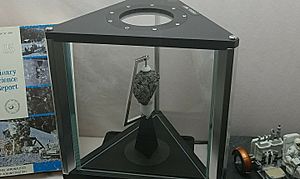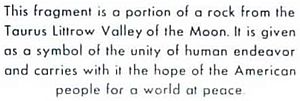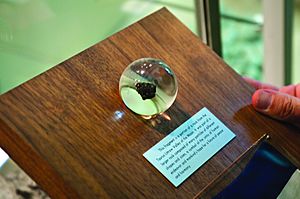Colorado lunar sample displays facts for kids
The Colorado lunar sample displays are special gifts given to the people of Colorado. These gifts are small pieces of Moon rock brought back by astronauts from the Apollo 11 and Apollo 17 missions. In the 1970s, U.S. President Richard Nixon gave these "goodwill gifts" to every state and many countries around the world.
Contents
Colorado's Moon Rock Gifts
Apollo 11 Moon Rocks
The Apollo 11 Moon rock display for Colorado has four tiny pieces of Moon rock. These pieces are about the size of a grain of rice. Astronauts Neil Armstrong and Buzz Aldrin collected them in 1969. The display also includes a small Colorado state flag. This flag traveled to the Moon and back with the Apollo 11 crew!
The four Moon rock pieces weigh very little, about 0.05 grams in total. They are sealed inside a clear plastic button, like a coin. This button is attached to a wooden board, which is about one foot square. The board sits on a small stand. Below the Moon rocks is the Colorado state flag that went to space. President Richard Nixon gave this display as a gift to Colorado. Similar displays were given to all other U.S. states and many countries.
Apollo 17 Moon Rocks
The Apollo 17 Moon rock display for Colorado is a plaque measuring about 10 by 14 inches. It holds one piece of Moon rock. This rock was cut from a larger Moon rock called "lunar basalt 70017." Astronaut Harrison Schmitt collected this rock on the Moon in 1972.
After the basalt rock came back to Earth, it was cut into small pieces. The piece for Colorado weighs about 1 gram. It is sealed in a plastic ball and attached to the wooden plaque. Just like the Apollo 11 display, this plaque also has a Colorado state flag. This flag also traveled to the Moon and back with the Apollo 17 astronauts. President Richard Nixon gave this gift to Colorado in 1973. He gave similar plaques to all 50 states. These gifts were meant to show friendship and promote peace.
The Story of Colorado's Moon Rocks
The Apollo 11 Moon rock plaque was first shown to the public around 1992. It was on the first floor of the Colorado State Capitol building. By 2010, the display was moved to a locked case on the third floor. Later that year, it was moved to a secret location. This happened because news reports said these Moon rocks might be worth a lot of money, possibly up to $5 million.
Even though the state government doesn't fully trust these high price estimates, a valuable item can attract people who might try to steal it. So, the state wanted to keep the Moon rocks safe.
The Apollo 17 Moon rock display was given to Colorado Governor John Vanderhoof in 1974 by NASA astronaut Jack Lousma. After that, the display was thought to be lost for many years. In June 2010, it was found at Governor Vanderhoof's home in Grand Junction, Colorado. He had left office in 1975 and said he didn't know what to do with the display, so he took it with him. The Apollo 17 Moon rock plaque is now on display at the Colorado School of Mines Geology Museum.







